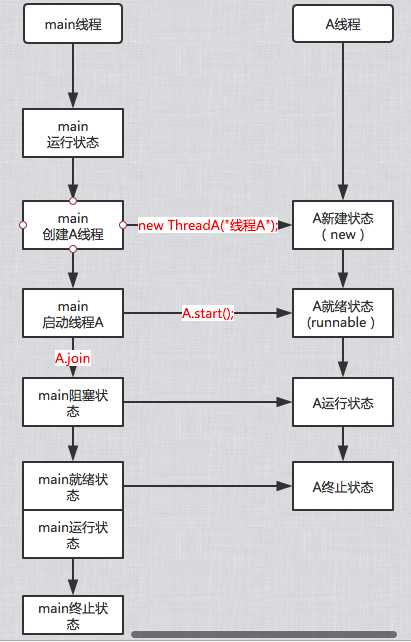标签:throws start ack lis param loop public recommend 父类
以下面例子说明下面的源码:main 线程 和 A线程,A线程是main线程创建并且启动的,main线程优先级比较高,正在执行;
这个时候main线程调用A.join()之后,main线程一直等待,直到A线程运行完毕,main线程才运行。join方法的源码:
* Waits at most {@code millis} milliseconds for this thread to
* die. A timeout of {@code 0} means to wait forever.
*
* <p> This implementation uses a loop of {@code this.wait} calls
* conditioned on {@code this.isAlive}. As a thread terminates the
* {@code this.notifyAll} method is invoked. It is recommended that
* applications not use {@code wait}, {@code notify}, or
* {@code notifyAll} on {@code Thread} instances.
*
* @param millis
* the time to wait in milliseconds
*
* @throws IllegalArgumentException
* if the value of {@code millis} is negative
*
* @throws InterruptedException
* if any thread has interrupted the current thread. The
* <i>interrupted status</i> of the current thread is
* cleared when this exception is thrown.
*/
// 加锁当前线程
public final synchronized void join(long millis)
throws InterruptedException {
long base = System.currentTimeMillis();
long now = 0;
if (millis < 0) {
throw new IllegalArgumentException("timeout value is negative");
}
if (millis == 0) {
//A线程是start,在运行中
while (isAlive()) {
//main线程等待
wait(0);
}
} else {
//join(timeOut)的情况
while (isAlive()) {
//根据当前timeout的时间-now 是否<=0进行判断,主线程是否继续阻塞等待
long delay = millis - now;
//等待超时时间到了,则主线程不阻塞了,等待结束
if (delay <= 0) {
break;
}
wait(delay);
//子线程从循环开始到现在运行的时间
now = System.currentTimeMillis() - base;
}
}
}
给一个例子来理解:
package concurrentMy.joins;
/**
*
* @author Administrator
*
* main 线程 和 A线程,A线程是main线程创建并且启动的,main线程优先级比较高,正在执行;
* 这个时候main线程调用A.join()之后,main线程一直等待,直到A线程运行完毕,main线程才运行
*
*/
class ThreadA extends Thread {
public ThreadA(String name){
super(name);
}
@Override
public void run() {
for (int i = 0; i < 20; i++) {
// 复写父类的toString方法, 返回该线程的字符串表示形式,包括线程名称、优先级和线程组。
System.out.println(Thread.currentThread().getName() + "-" + i);
}
}
}
public class JoinDemo {
/**
* @param args
* @throws InterruptedException
*/
public static void main(String[] args) throws InterruptedException {
ThreadA A = new ThreadA("线程A");
A.start();
A.join(); //A线程加入到“main线程”中,main线程一直等待,直到A线程执行完毕,main线程才运行
System.out.println(Thread.currentThread().getName() + "执行");
System.out.println(Thread.currentThread().getName() + "执行终止");
}
}
输出结果:
线程A-0
线程A-1
线程A-2
线程A-3
线程A-4
线程A-5
线程A-6
线程A-7
线程A-8
线程A-9
线程A-10
线程A-11
线程A-12
线程A-13
线程A-14
线程A-15
线程A-16
线程A-17
线程A-18
线程A-19
main执行
main执行终止
代码运行整个过程说明入下图:

java基础知识回顾之java Thread类学习(十一)--join方法的理解
标签:throws start ack lis param loop public recommend 父类
原文地址:http://www.cnblogs.com/200911/p/6027358.html